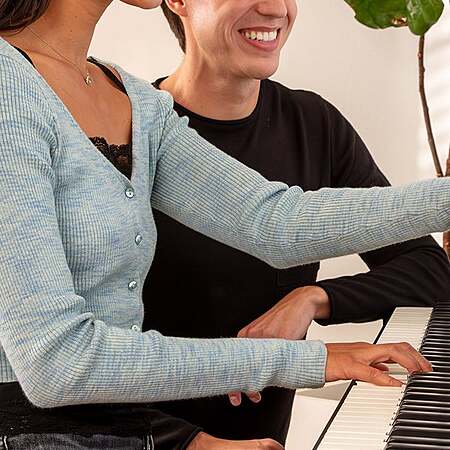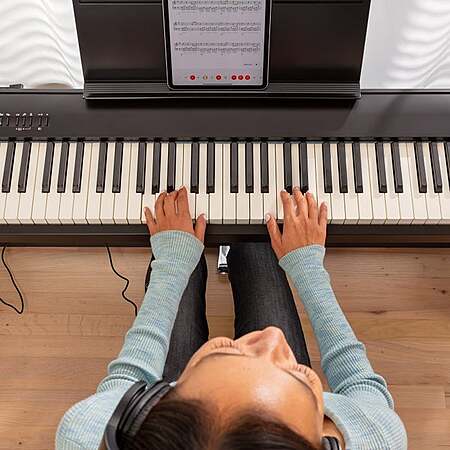expiredslickcouponsman posted Oct 18, 2024 05:04 AM
Item 1 of 4
Item 1 of 4
expiredslickcouponsman posted Oct 18, 2024 05:04 AM
Costco Members: Roland FRP Nuvola Digital Piano Bundle
+ $80 S&H$600
$700
14% offCostco Wholesale
Visit RetailerGood Deal
Bad Deal
Save
Share




Leave a Comment
Top Comments
This has the PHA-4 action, which Roland uses on its weighted low to mid-range digital pianos (up to about $2k). It is more sophisticated than the simple weighting on low-end models that just use static resistance. It simulates some things like "escapement" - when you strike a key on an acoustic piano, the hammer releases from the string after it strikes so the note keeps going, and this transmits to the key with a sensation you can feel.
The downside people generally agree exists with this action is that the return (key coming back up) is a little slow and this is part of why some people prefer the action on Yamaha, Kawai, Korg, etc. I have found grace notes and sixteenth notes in arpeggios and scales are all fine but it is a bit mushy for repeated sixteenth notes. But I also got this to learn coming from a musical background with other instruments so I'm not the best judge.
If your eyes glazed over, this is a well-regarded action and the same one found in the FP-10 and FP-30X that are ubiquitous "first quality beginner piano" recommendations. It will satisfy what people generally recommend when they say "buy a digital piano with weighted keys."
As others have said the Roland action is sluggish on the return and also weighted a bit heavier than most other digital. Not good for small hands or for children. For me personally it is very fatiguing to play. Also not good for playing classical music with lots of runs, trills, or passages that need a delicate touch, because the action will slow down your fingers.
A lot of it comes down to personal preference but imo Roland is just not suited well for classical. Their brand is targeted at people who play other styles of music and people who gig. Casio has been trying to shift over to that with their slimline pianos which have terrible actions, but many people enjoy those. The older model Privias have better actions.
The Casio PX870/770 are console style pianos with a lid. I would rather have the lid than a bench. I've never really understood the purpose of having a slab piano attached to a proprietary stand like this Roland. It's nice that it comes with the pedals, but if I'm putting something together that is just going to stay in my house, I want it to have a lid over the keys like a traditional piano.
If I wanted a Roland, I would either wait for an Adorama deal on an FP model, or wait for Costco to run one of their deals on a console Roland. However for a console, Casio deals are much lower cost and more for the money.
This unit is rather newer on the market and even Rolands website is scarce with regards to available information. In terms of accessories and connectivity, the Roland is in line with the Privia 860... which had dual headphone out and other features (the 870 does not have that) and neither does it (870) have line-out to connect to a sound system.
If you're learning how to play or newer to playing, I would say go for the Roland. I have not heard the Roland but I know what the 870 sounds like and it has very good sampling (meaning, the instruments sound authentic). There is a roll top cover (on the 870) to protect the keys when not in use and it has a lid that will simulate (very well) a grand piano when playing with the lid open or closed.
In the pic, the privia is the one on the left with the keyboard lid closed
45 Comments
Sign up for a Slickdeals account to remove this ad.
Some reddit discussion of it and a bit of information from Roland comparing it to the FP30X. I have it and the piano designer function does work with lid/pads/adjusting stretch tuning/etc. There is a pretty extensive list of GM2 sounds available through the app too.
Some reddit discussion of it and a bit of information from Roland comparing it to the FP30X. I have it and the piano designer function does work with lid/pads/adjusting stretch tuning/etc. There is a pretty extensive list of GM2 sounds available through the app too.
This has the PHA-4 action, which Roland uses on its weighted low to mid-range digital pianos (up to about $2k). It is more sophisticated than the simple weighting on low-end models that just use static resistance. It simulates some things like "escapement" - when you strike a key on an acoustic piano, the hammer releases from the string after it strikes so the note keeps going, and this transmits to the key with a sensation you can feel.
The downside people generally agree exists with this action is that the return (key coming back up) is a little slow and this is part of why some people prefer the action on Yamaha, Kawai, Korg, etc. I have found grace notes and sixteenth notes in arpeggios and scales are all fine but it is a bit mushy for repeated sixteenth notes. But I also got this to learn coming from a musical background with other instruments so I'm not the best judge.
If your eyes glazed over, this is a well-regarded action and the same one found in the FP-10 and FP-30X that are ubiquitous "first quality beginner piano" recommendations. It will satisfy what people generally recommend when they say "buy a digital piano with weighted keys."
Sign up for a Slickdeals account to remove this ad.
This has the PHA-4 action, which Roland uses on its weighted low to mid-range digital pianos (up to about $2k). It is more sophisticated than the simple weighting on low-end models that just use static resistance. It simulates some things like "escapement" - when you strike a key on an acoustic piano, the hammer releases from the string after it strikes so the note keeps going, and this transmits to the key with a sensation you can feel.
The downside people generally agree exists with this action is that the return (key coming back up) is a little slow and this is part of why some people prefer the action on Yamaha, Kawai, Korg, etc. I have found grace notes and sixteenth notes in arpeggios and scales are all fine but it is a bit mushy for repeated sixteenth notes. But I also got this to learn coming from a musical background with other instruments so I'm not the best judge.
If your eyes glazed over, this is a well-regarded action and the same one found in the FP-10 and FP-30X that are ubiquitous "first quality beginner piano" recommendations. It will satisfy what people generally recommend when they say "buy a digital piano with weighted keys."
Our community has rated this post as helpful. If you agree, why not thank lilnicola
As others have said the Roland action is sluggish on the return and also weighted a bit heavier than most other digital. Not good for small hands or for children. For me personally it is very fatiguing to play. Also not good for playing classical music with lots of runs, trills, or passages that need a delicate touch, because the action will slow down your fingers.
A lot of it comes down to personal preference but imo Roland is just not suited well for classical. Their brand is targeted at people who play other styles of music and people who gig. Casio has been trying to shift over to that with their slimline pianos which have terrible actions, but many people enjoy those. The older model Privias have better actions.
The Casio PX870/770 are console style pianos with a lid. I would rather have the lid than a bench. I've never really understood the purpose of having a slab piano attached to a proprietary stand like this Roland. It's nice that it comes with the pedals, but if I'm putting something together that is just going to stay in my house, I want it to have a lid over the keys like a traditional piano.
If I wanted a Roland, I would either wait for an Adorama deal on an FP model, or wait for Costco to run one of their deals on a console Roland. However for a console, Casio deals are much lower cost and more for the money.
This has the PHA-4 action, which Roland uses on its weighted low to mid-range digital pianos (up to about $2k). It is more sophisticated than the simple weighting on low-end models that just use static resistance. It simulates some things like "escapement" - when you strike a key on an acoustic piano, the hammer releases from the string after it strikes so the note keeps going, and this transmits to the key with a sensation you can feel.
The downside people generally agree exists with this action is that the return (key coming back up) is a little slow and this is part of why some people prefer the action on Yamaha, Kawai, Korg, etc. I have found grace notes and sixteenth notes in arpeggios and scales are all fine but it is a bit mushy for repeated sixteenth notes. But I also got this to learn coming from a musical background with other instruments so I'm not the best judge.
If your eyes glazed over, this is a well-regarded action and the same one found in the FP-10 and FP-30X that are ubiquitous "first quality beginner piano" recommendations. It will satisfy what people generally recommend when they say "buy a digital piano with weighted keys."
If you're just starting with piano, take a look at the pieces in the Faber or Alfred adult 1 and 2 books. You're unlikely to routinely play repeated sixteenth notes at allegro or faster (a likely edge case) for a couple years, and then really only if you're training to play classical pieces. Like every hobby where $600-700 is "entry level," it's a rabbit hole of tradeoffs, and I personally would buy again rather than spend a few months not playing waiting for something else. But I did spend a day or two a teeny bit bummed about the return.
Sign up for a Slickdeals account to remove this ad.
Our community has rated this post as helpful. If you agree, why not thank LightningDemon
This unit is rather newer on the market and even Rolands website is scarce with regards to available information. In terms of accessories and connectivity, the Roland is in line with the Privia 860... which had dual headphone out and other features (the 870 does not have that) and neither does it (870) have line-out to connect to a sound system.
If you're learning how to play or newer to playing, I would say go for the Roland. I have not heard the Roland but I know what the 870 sounds like and it has very good sampling (meaning, the instruments sound authentic). There is a roll top cover (on the 870) to protect the keys when not in use and it has a lid that will simulate (very well) a grand piano when playing with the lid open or closed.
In the pic, the privia is the one on the left with the keyboard lid closed
Leave a Comment